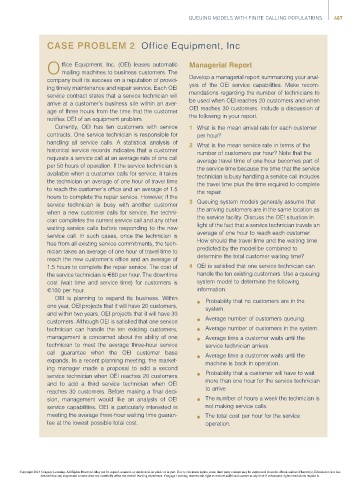Page 507 -
P. 507
QUEUING MODELS WITH FINITE CALLING POPULATIONS 487
CASE PROBLEM 2 Office Equipment, Inc
ffice Equipment, Inc. (OEI) leases automatic Managerial Report
O mailing machines to business customers. The
Develop a managerial report summarizing your anal-
company built its success on a reputation of provid-
ysis of the OEI service capabilities. Make recom-
ing timely maintenance and repair service. Each OEI
mendations regarding the number of technicians to
service contract states that a service technician will
be used when OEI reaches 20 customers and when
arrive at a customer’s business site within an aver-
OEI reaches 30 customers. Include a discussion of
age of three hours from the time that the customer
the following in your report.
notifies OEI of an equipment problem.
Currently, OEI has ten customers with service 1 What is the mean arrival rate for each customer
contracts. One service technician is responsible for per hour?
handling all service calls. A statistical analysis of
2 What is the mean service rate in terms of the
historical service records indicates that a customer
number of customers per hour? Note that the
requests a service call at an average rate of one call
average travel time of one hour becomes part of
per 50 hours of operation. If the service technician is
the service time because the time that the service
available when a customer calls for service, it takes
technician is busy handling a service call includes
the technician an average of one hour of travel time
the travel time plus the time required to complete
to reach the customer’s office and an average of 1.5
the repair.
hours to complete the repair service. However, if the
3 Queuing system models generally assume that
service technician is busy with another customer
the arriving customers are in the same location as
when a new customer calls for service, the techni-
the service facility. Discuss the OEI situation in
cian completes the current service call and any other
light of the fact that a service technician travels an
waiting service calls before responding to the new
average of one hour to reach each customer.
service call. In such cases, once the technician is
How should the travel time and the waiting time
free from all existing service commitments, the tech-
predicted by the model be combined to
nician takes an average of one hour of travel time to
determine the total customer waiting time?
reach the new customer’s office and an average of
1.5 hours to complete the repair service. The cost of 4 OEI is satisfied that one service technician can
the service technician is E80 per hour. The downtime handle the ten existing customers. Use a queuing
cost (wait time and service time) for customers is system model to determine the following
E100 per hour. information:
OEI is planning to expand its business. Within
l Probability that no customers are in the
one year, OEI projects that it will have 20 customers,
system.
and within two years, OEI projects that it will have 30
l Average number of customers queuing.
customers. Although OEI is satisfied that one service
technician can handle the ten existing customers, l Average number of customers in the system.
management is concerned about the ability of one l Average time a customer waits until the
technician to meet the average three-hour service service technician arrives.
call guarantee when the OEI customer base
l Average time a customer waits until the
expands. In a recent planning meeting, the market-
machine is back in operation.
ing manager made a proposal to add a second
l Probability that a customer will have to wait
service technician when OEI reaches 20 customers
more than one hour for the service technician
and to add a third service technician when OEI
to arrive.
reaches 30 customers. Before making a final deci-
sion, management would like an analysis of OEI l The number of hours a week the technician is
service capabilities. OEI is particularly interested in not making service calls.
meeting the average three-hour waiting time guaran- l The total cost per hour for the service
tee at the lowest possible total cost. operation.
Copyright 2014 Cengage Learning. All Rights Reserved. May not be copied, scanned, or duplicated, in whole or in part. Due to electronic rights, some third party content may be suppressed from the eBook and/or eChapter(s). Editorial review has
deemed that any suppressed content does not materially affect the overall learning experience. Cengage Learning reserves the right to remove additional content at any time if subsequent rights restrictions require it.

